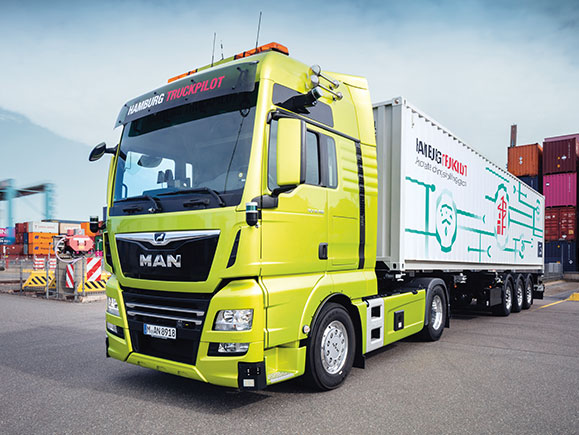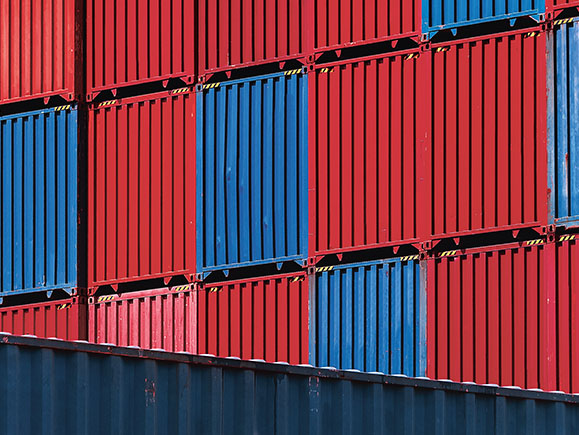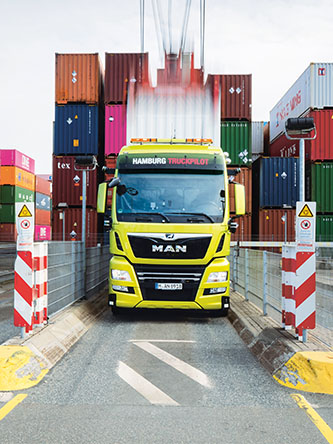MAN has partnered with Hamburger Hafen und Logistik AG to research and trial highly automated and autonomous trucks. The “Hamburg TruckPilot” project paves the way for a considerably more efficient cargo handling process at major sea ports.
The heart of the port city beats in the south of Hamburg. Of the 135 million tons of cargo handled here at the port in 2018, two-thirds was with containers. A total of 9 million standard containers are loaded and unloaded by giant gantry cranes every year. And for 56% of all containers, it is trucks that ensure that the cargo arrives on time at the port. The entire port area makes up one massive logistics machine, with trucks accessing it a total of 4.3 million times a year—given this magnitude, the port is dependent on smooth processes. It is in this environment that MAN, in partnership with Hamburger Hafen und Logistik AG, intends to begin a unique experiment. It is unique because the plan is to test fully automated driving on public roads before the trucks even arrive at the port. This is considered level 3 automation by experts: although a driver is still in the vehicle, he or she can at times do other tasks. And once the truck has arrived at the Altenwerder container terminal, the driver can even leave the vehicle, as it is fully autonomous during unloading and subsequent loading. “For the first time, we are bringing the two worlds together in one single vehicle under real-life conditions,” explains Walter Schwertberger, who coordinates research and development for automated driving at MAN. “That’s what makes this one of the most ambitious and important projects we have ever carried out.”
TRUCKPILOT
WITH DRIVER
After the trucks complete the fully autonomous drive into the port, they will be unloaded and loaded
autonomously at the Altenwerder container terminal.
DRIVERLESS
If truck traffic can be synchronized with container logistics at the port, handling times will be
reduced and efficiency improved.
AT THE PORT
Loading and unloading of container ships is already computer-controlled 24 hours a day, seven days a
week.
THE OPERATOR
In a fully autonomous scenario, an operator monitors the process. Initially, however, a safety driver
will be on board the vehicle.
Two different operating modes
The main technical challenge for the MAN engineers is that the environment conditions for both operating modes differ considerably. A container terminal is a structured environment in which usually there aren’t any unexpected events. And when something unexpected does occur, the vehicle simply stops, and is immediately in a safe area. A very different scenario plays out on the highway, where objects in the lane or vehicles cutting in might require more sophisticated driving maneuvers. “That impacts the sensors used, the self-localization, and the algorithms that help us to control the vehicle,” explains Schwertberger.
The vehicle is fully autonomous during unloading and subsequent loading.
For that reason, Sebastian Völl, project manager at MAN, is currently focusing on configuring two semitrailer tractors that will be trialed in real-life conditions in port logistics in the coming year. Along with their own research findings, developers can draw on the expertise of the Volkswagen Group in the areas of sensor technology, which also includes laser scanners, and computer programs used to analyze environmental data. “This gives us a tremendous advantage,” says Völl. “However, we have to customize the hardware and software to the requirements of heavy-duty commercial vehicles.” This is especially the case for the algorithms used to calculate steering and braking behavior. It is where MAN benefits the most from its own projects, as well as from the collaboration with experts at Scania. “The synergies leveraged within the TRATON GROUP enable us to achieve demonstrable results more quickly,” says Völl.
Trial operations to start at the end of 2020
Having said that, this is pioneering work and not series development. At the end of 2020, the trial operations, carried out with a specially trained safety driver, are to take place without disrupting the container terminal processes. In October 2021, the “Hamburg TruckPilot” will be showcased at the World Congress on Intelligent Transport Systems (ITS) in Hamburg, with an audience of several thousand transportation and logistics experts visiting from around the world.
Autonomous driving presents enormous long-term potential for all ports around the world: although loading and unloading of container ships is already computer-controlled 24 hours a day, seven days a week, that is not the case for truck delivery. This tends to take place during business days and is done during the day so the drivers can adhere to the legally prescribed driving and rest periods. That’s why, according to official statistics, the truck parking lots at the Port of Hamburg are 99% full at night. If truck traffic can be synchronized with container logistics at the port, handling times will be reduced and, at the same time, efficiency improved.


Trucks access the Port of Hamburg 4.3 million times a year.



.jpg/jcr:content/Teaser-Grafik-Tiva-Sharifi-3840x2560-V1-(1).jpg
)
.jpg/jcr:content/Teaser-Grafik-Mansoureh-3840x2560-V1-(1).jpg
)


